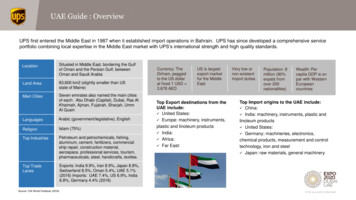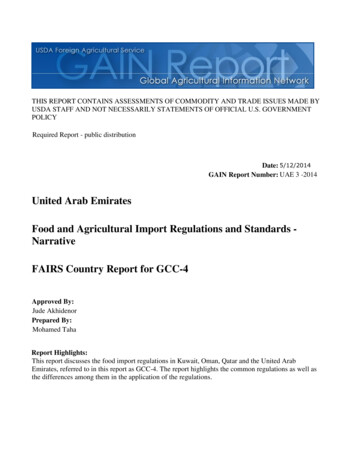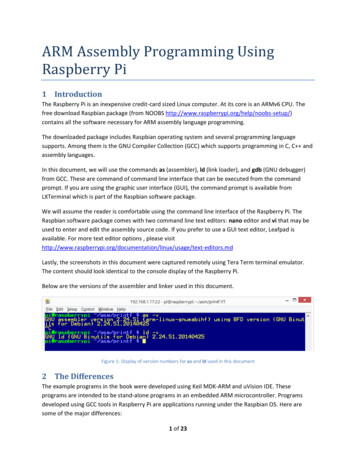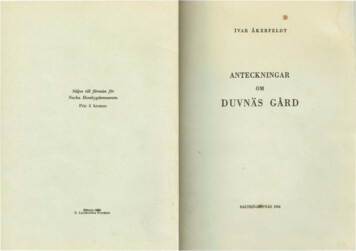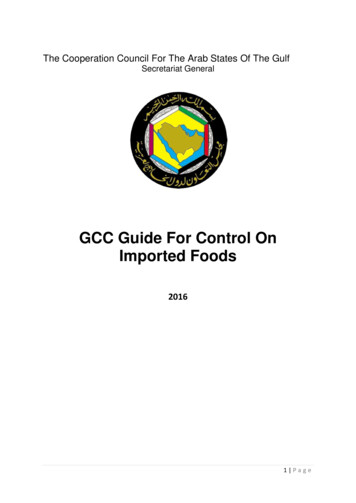
Transcription
The Cooperation Council For The Arab States Of The GulfSecretariat GeneralGCC Guide For Control OnImported Foods20161 Page
GCC Guide for Control on Imported FoodsIntroductionThe department of Agriculture and Fisheries Resources at the Economic Affairs ofthe Secretariat General of the Cooperation Council for the Arab States of the Gulfhereinafter (GCC), is privileged to print the GCC Guide for the Control of Imported Food.The GCC Ministers in charge of Food Safety adopted the amendments on the firstversion at their 3rd meeting held at the GCC Headquarter in June 2016.Printing this guide is based on the believe of the General Secretariat of the (GCC) inthe dissemination of information in all transparency to allow anyone to get an access toit achievements, regulations and all the materials related to the joint cooperation amongits member states. The GCC believes it important that interested parties and peopleshould be familiar with the achievements of the (GCC) and make use of those referencesin various specializations as well giving chances for the others to realize on the decisionsadopted by the GCC countries in the field of systems and common legislation. This guideis one of many achievements adopted jointly in the area of food safety.The GCC states import most of its consuming food and live animals from outsidecountries, and since these nutrients, while essential to the life of the individual andsociety, also represent health challenges for humans and concerns for the environmentsafety. Therefore, the Ministerial Committee for Food Safety of GCC acknowledged theimportance of a collective coordination and establishing joint laws and regulations oflaws in food safety. The importance of the Guide for the control of imported food comesas part of the efforts to consolidate and facilitate the import and complete inspectionson consignments of imported food procedures, depending on the degree of health riskand without prejudice to the obligations of Member States About the WTO agreementsand compatible with international best practices in this area.This guide illustrates the commitment of Member States to apply food controlprocedures based on the principle of severity of imported food and in line with expectedconsumer health and rights to get high quality of food with no health risk. The items andregulations stipulated in the guide have taken into account the GCC member statescommitments on international laws and regulations such as WTO, FAO, and OIE.Agriculture and Fisheries Resources Directorate2 Page
Table of Contents1. Introduction 2. Scope .3. Definitions: 4.Principles .5. Risk-based Approach to food safety requirements 5.1. Factors taken into account in application of the risk-based food control system .5.2. Risk-based food control system .6. Required Documents and Health Certificates 6.1 Required Documents and Health certificates .6.2 Health Attestations: .6.2.1 Health Attestations for Export of Processed Food . .6.2.2 Health Attestations for Export of Meat and Meat Products . .6.2.3 Health Attestations for Export of (Milk, and Milk Products) 6.2.4 Health Attestations for Export of Table Eggs and Egg Products .6.2.5 Health Attestations for Export of Products of Aquatic Animal Origin .6.2.6 Phytosanitary Attestations for Export of Plant and Plant products .6.2.7 Health Attestations for Export of Assorted Foods .6.2.8 Health Attestations for Export of Honey .6.3. Halal Attestations /Halal Slaughtering Attestations 6.3.1 Halal Slaughtering Attestations for Export of Meat and Meat Products .6.3.2 Halal Attestations for Export of Products of Animal Origin .7. Inspection and clearance of imported foods 7.1. Reserve notification and detention of consignment .7.2. Temporary release .7.3. Automatically detained food .8. Food imported for non-commercial purposes .9. Food prohibited from importation on food safety grounds .10. Prohibition of importation of foods on sanitary or phytosanitary grounds .Appendix (1): GCC Imported food Control procedures Flow Chart .Appendix (2): Health certificates Forms .Template No (1) Health certificate for export of processed food .Template No (2): Health Certificate for Export of Meat and Meat Products .Template No (3) Health Certificate for Export of (milk, and Milk Products) .Template No (4) Health Certificate for Export of Table Eggs and Egg Products Template No: (5) Health Certificate for Export of Products of Aquatic Animal Origin Template No: (6) Phytosanitary Certificate for Export of Plant and Plant products .Template No: (7) Health Certificate for Export of Assorted Products Template No: (8) Health Certificate for Export of Honey .Appendix (3): Halal Certificate/Halal Slaughtering Certificate Forms .Template No: (1) Halal Slaughtering Certificate for Export of Meat and Meat Products.Template No: (2) Halal certificate for Export of products of Meat Origin .Appendix No (4): List of GCC Requirements: Technical Regulations & Standards .Appendix (5) List of Food Categories' and their Certification Requirements 26272931323334353637383940414243563 Page
1. IntroductionThe competent authorities responsible for food control in the GCC countries recognizethat effective and efficient inspection and certification systems are fundamentalcomponents of the trade in food. The competent authorities of the GCC have thecommon goal of an integrated and harmonized import inspection and certificationsystem that is best practice, risk-based and meets without prejudice the obligations ofthe relevant World Trade Organization agreements. This system will be fit for purposeand will ensure consumer protection while facilitating trade.The competent authorities of the GCC have the responsibility of ensuring that all foodarriving in the GCC countries complies with the relevant GCC requirements1. Allimported food will be subjected to health control at the point of entry to ensure that foodcomplies with the GCC technical regulations and requirements (refer to appendix No.4).The means of assurance provided by exporting countries can be provided in a numberof ways e.g. documentation and certification, reference to other assurances providedthrough inspection activities by the competent authority in the exporting country or anofficially-recognized party, trading arrangements based on the history of compliance ofprevious shipments of known origin.This Guide documents a commitment to science-based import control systems andclearance procedures that are: applied in proportion to potential risks to consumers fromimported food; responsive to new or emerging risks that may arise in the global foodsupply. They also address non-food safety (i.e. food suitability) requirements2 in atransparent and objective manner.2. ScopeThis Guide describes principles and regulatory requirements to be applied by theexporting country and the importing GCC countries in assuring the safety and suitabilityof shipments of imported food.3 Specific attestations for animal and plant healthcertification are also provided in the Guide.1All GCC food standards and technical regulations are available at GSO website: www.gso.org.saThe GCC food imports Guide tackles food suitability issues related to ethnic/religious considerations such asHalal food and labeling issues, which are considered as legitimate factors.3Foods imported for personal use are not subject to the requirements in this guideline and are allowed where thepackaging is intact and provides sufficient information to allow entry e.g. name and number of foodestablishment in the country of origin.24 Page
The Guide incorporates Codex, OIE, IPPC standards as international benchmarks whereappropriate.There is ongoing work in the GCC countries to harmonize all regulatory requirementsfor imported foods and provide a coordinated and efficient border inspection andclearance system. While regulatory requirements and procedures for imported foods arenot as yet fully harmonized between the countries of the GCC, this Guide will contributeto the harmonization process. In particular, the countries of the GCC will continue towork towards a fully risk-based approach to assure the safety of imported foods.3. Definitions:The following words and expressions shall, unless the context otherwise requires, havethe meaning hereby assigned to themAdulteratedfoodFood where certain materials have been added to its originalingredients affects it by reducing its quality and nutritional value, orwhere some of the nutrients have been removed partially or entirely,or a general permitted additive has been added to the product,without disclosing these changes on the food label.AquaticAnimalsall life stages (including eggs and gametes) of fish, molluscs,crustaceans and amphibians originating from aquacultureestablishments or removed from the wild, for farming purposes, forrelease into the environment or for human consumption.Assorted FoodProductsA variety of food products which are shipped in the sameconsignment which do not belong to: meat and meat products; fishand fish products; milk and milk products; eggs and egg products;honey or bee products. The certificate for assorted products can beused for products such as spices, dry fruits, desiccated coconut,sauces, tea, coffee, packaged breakfast cereals, packaged nuts,vegetable oils, packaged dry fruits etc. One certificate can be usedfor multiple products.Certificate offitness forConveyanceCertificate issued by the concerned party (i.e. exporter, shippingagency or officially recognized third party) in the country of originor exporting country that assures the fitness of the conveyance usedfor transporting food and proves the suitability to transport theexported food.CompetentauthorityThe official body or officially-recognized body that has regulatoryjurisdiction for food control.5 Page
CondemnationThe action taken by the competent regulatory authorities of theimporting GCC countries to dispose rejected food proved unfit forhuman consumption.ConditionalreleaseAction taken by the competent authority to allow release of aconsignment of food to the importer under prescribed conditions.Consignment / A defined collection of food products normally covered by a singlecertificate. It may consist in either a portion of a lot, either a set ofShipmentseveral lots.ContaminantAny substance not intentionally added to food, which is present insuch food as a result of the production (including operations carriedout in crop husbandry, animal husbandry and veterinary medicine),manufacture, processing, preparation, treatment, packing,packaging, transport or holding of such food or as a result ofenvironmental contamination. The term does not include insectfragments, rodent hairs and other extraneous matter.Delivery noticeAn official document that authorizes the transfer of goods from theport of entry to the area of food inspection.DocumentaryCheckThe process of reviewing andaccompanying a food consignment.EquivalenceThe capability of different inspection and certification systems tomeet the same objectives; i.e. the state where in sanitary measuresapplied in an exporting country, though different from the measuresapplied in an importing country, achieve, as demonstrated by theexporting country, the importing country’s appropriate level ofsanitary protection.Fitness forhumanconsumptionFood that is fit for human consumption according to its end use asspecified by the technical regulations of the GCC, or approvedalternative equivalent measures.FoodAny substance, whether processed, semi-processed or raw, which isintended for human consumption, and includes drink, chewing gumand any substance which has been used in the manufacture,preparation or treatment of food but does not include cosmetics ortobacco or substances used only as drugsFood ControlMandatory, regulatory activity, carried out by the competent controlauthorities, for the purposes of protecting the health of consumersand to ensure the safety of food during all stages of food chain.verifyingalldocuments6 Page
Food chainAll stages of food handling, including the primary production,importing, exporting, manufacturing, preparation, processing,wrapping, packaging, transporting, storing, distributing, servingand selling.Food HandlingProduction of food or manufacturing, preparation, processing,wrapping, packaging, catering, transporting, possessing, storing,distributing, serving, selling or donating for the purpose of humanconsumption.Food HygieneAll conditions and measures necessary to ensure the safety andsuitability of food at all stages of the food chain.FoodInspectionExamination of food or food safety systems by the competentauthorities in the importing country, for the purposes of control ofproduction inputs, processes and final products through all stages offood chain, to verify their conformity to the technical regulations ofthe GCC, or approved alternative equivalent measures.Food labelAny tag, brand, mark, pictorial or other descriptive matter, written,printed, stencilled, marked, embossed or impressed on, or attachedto, a container of food.Food SafetyAssurance that food will not cause harm to the consumer when it isprepared and/or eaten according to its ended use.FoodSuitabilityAssurance that Food is acceptable for human consumptionaccording to its ended use.Food safetymanagementsystemA comprehensive system for all the procedures and controlmeasures to ensure food safety, including the application of goodhygiene practice (GHP), Hazard Analysis and Critical Control Point(HACCP), and traceability.GoodOperationalPracticesA set of good practices related to food / feed and the surroundingenvironment, including any process, which includes goodagricultural practices, good veterinary practices, good hygienepractices, good manufacturing practice.FoodTraceabilityThe ability to follow the movement of a food through all stage(s) ofproduction, processing and distribution.HazardAnalysis andCriticalA scientific system which identifies, evaluates, and controls hazardswhich are significant for food safety.7 Page
Control Points(HACCP)4HalalCertificateCertificate issued by the country of origin or country of exportationby an accredited (GCC) Islamic agency (society), attesting that: theproduct (such as meat, fat, gelatin, rennet, the broth) has beenprepared , produced and circulated in accordance with the rules ofIslamic Sharia law; or the food which contains animal products orby-products is halal and has been produced in accordance with therules of Islamic Sharia law; and that the food has been handled withequipment and instruments which are not against the teachings ofIslamic Sharia law and in accordance with the GCC ertificate issued by the country of origin by an accredited (GCC)Islamic agency (society), attesting that: the animal has beenslaughtered in accordance with the rules of Islamic Sharia.HazardA biological, chemical or physical agent in, or condition of, foodwith the potential to cause an adverse health effectHealthCertificate4Certificate (paper or electronic) issued by the competent authorityin the country of origin or the country of exportation, attesting thatthe safety (and suitability) of the consignment of food is inaccordance with the relevant technical regulations of the GCC(including registration numbers of food establishments), orapproved alternative equivalent measures.Health claimAny representation on a food label, that states, suggests, or impliesthat a relationship exists between a food or a constituent of that foodand health. It includes the following:Nutrient function claims – a nutrition claim that describes thephysiological role of the nutrient in growth, development andnormal functions of the bodyOther function claims – These claims concern specific beneficialeffects of the consumption of foods or their constituents, in thecontext of the total diet on normal functions or biological activitiesof the body. Such claims relate to a positive contribution to healthor to the improvement of a function or to modifying or preservinghealth.The certificate template should be in certain format approved by GCC which is based on principles stated oncodex. (Ref: codex CAC/GL 38-2001(8 Page
Reduction of disease risk claims – Claims relating the consumptionof a food or food constituent, in the context of the total diet, to thereduced risk of developing a disease or health-related condition.Processed Food Food items of one product type which have been subjected toprocessing such as canning, cooking, freezing, dehydration ormilling but do not belong to the following categories in the GCCGuide: meat and meat products; fish and fish products; milk andmilk products; eggs and egg products; honey or bee products.ProductIdentity CheckA visual inspection verifying all documents and certificatesaccompanying the consignment and making sure they match theproduct itself.ImporterA person or legal entity importing food to GCC.List of contentsA packing List or invoice or any document issued by the exportingcompany in the country of origin or country of export, whichdescribes and quantifies the food in the consignment.Lot/batchA definitive quantity of a commodity produced essentially under thesame conditions have uniform characteristics such as origin,producer, packer, markings, consignor, batch No. etc.MicrobialcontaminationThe presence of microorganisms, including pathogens and theirtoxins, accidentally in food during handling within the food chain.Milk ProductIs product obtained by any processing of milk, which may containfood additives, and other ingredients functionally necessary for theprocessingNutritionclaimAny representation on a food label which states, suggests or impliesthat a food has particular nutritional properties including but notlimited to the energy value and to the content of protein, fat andcarbohydrates, as well as the content of vitamins and minerals andincludes:Nutrient content claim is a nutrition claim that describes the levelof a nutrient contained in a food.Nutrient comparative claim is a claim that compares the nutrientlevels and/or energy value of two or more foods.Port of entryLand, sea or airport customs border which is designated as an entrypoint for shipments imported into any of the GCC countries.9 Page
5PreventivedetentionAction taken by the competent authority to detain a consignment offood at the port of entry when the food is suspected of not beingcompliant with GCC technical regulations.Physicalexamination/CheckAn actual physical evaluation (using sight, sense and smell) of food,label and packaging at the border of entry without the resource forlaboratory analysis, including the visual inspection for generalconditions of the consignment and the product identity check of itscontents.Release for reexportAction taken by the competent authority, under official controls, toallow an importer to re-export a consignment not presenting anyhealth hazard of food in its entirety within a prescribed time limit,having met all documentary and customs requirements, providedthat the food is not used during the holding time and availingdocuments that prove the re-export of such consignment.ReservenotificationWhere a consignment of food is found to be non-compliant withGCC requirements, the Competent Authority will issue a reservenotification that states the reason for the reservation and the productwill be detained under official control.RiskA function of the probability of an adverse health effect and theseverity of that effect, consequential to a hazard(s) in food.Risk analysisOrganized decisions making process related to food safety, basedon a scientific basis and developing necessary precautions tomanage a process consisting of three components: risk assessment,risk management and risk communication.Sanitarymeasures5Any measure applied to protect human life or health within theterritory of the country from risks arising from additives,contaminants, toxins or disease-causing organisms in food orfeedstuffs, or from risks arising from diseases carried by foodswhich are animals, plants or products thereof or from risks arisingfrom any other hazards in foods.RequirementsThe criteria set down or required by the competent authoritiesrelating to trade in foodstuffs covering the protection of publichealth, the protection of consumers and conditions of fair trading.Sanitary measures include all relevant laws, decrees, regulations, requirements and procedures including, interalia, end product criteria; processes and production methods; testing, inspection, certification and approvalprocedures; provisions on relevant statistical methods, sampling procedures and methods of risk assessment;and packaging and labeling requirements directly related to food safety10 P a g e
StandardsA document that lays down, for normal and frequent use, the rulesand instructions or characteristics of the products, operations orrelevant methods of production thereof, the adherence to whichshall not be compulsory. This document may include or examine inparticular the terms, definitions, packing and the marking orlabeling requirements to be applied to the products, operations orthe methods of production.Statement ofentry (customsdeclaration)Document provided by the owner or his representative describingthe food to be imported and that is in accordance with the relevantcustoms requirements of the GCC.TechnicalregulationsRequirements issued by the GSO (Gulf Standards Organization)which are mandatory.TemperaturereadingsRecord duringtransportTotal reading (paper or electronic) of temperatures during thetransport of refrigerated and frozen food, through the use of(Thermographs) devices to measure the circulating air temperatureor food temperatureTemporaryreleaseAction taken by the competent authority, under official controls, toallow, the importer to transfer a consignment of food from the portof entry to a warehouse, pending issuance of an official decision onrelease.ConveyanceAny means including any part thereof, designated to transport foodwhether by sea, land or air.4. PrinciplesAll food shipments/consignment imported to the countries of the GCC shall be subjectto harmonized regulatory requirements6. Regulatory requirements will be subject tocontinuous review as the countries of the GCC work towards a fully unified regulatoryenvironment7.Inspection and certification requirements applying to food safety aspects of importedfood will be risk-based to the greatest extent practicable, with control measures appliedin proportion to likely risks to the consumer. The type and frequency of inspection at67The guide is considered a mandatory legal tool that will regulate the imports in a harmonized manner, thusoptimizing resources and avoiding redundancy of procedures in the inter-trade between the GCC countries.The GCC member countries are currently developing an “implementation guide” that will provide moreoperational dimension to the means of conducting the inspection and scenario based tools to ensure consistencyin decision making.11 P a g e
the time of import of shipments of food, and clearance procedures, will reflect thisapproach.The technical regulations and standards of the GCC countries will be used as theprimary basis for certification of food shipments by exporting countries. Where deemedappropriate by the GCC e.g. where current GCC technical regulations and standards arenot comprehensive in terms of specific requirements for certain imported foods, theGCC may defer to Codex, OIE and IPPC standards, guidelines and recommendationsas the basis for certification (and other assurances).All aspects of the GCC inspection and certification systems will be documented andtransparent, with details of regulatory requirements and operational procedures beingmade available to exporting countries and other stakeholders as requested.The competent authorities of the GCC countries will strive for uniform implementationof regulatory requirements and operational procedures in the advent of multiple entrypoints for imported foodsCertification of shipments, accompanied by full documentation of the details of eachfood shipment, are key components of import food controls applied by the countries ofthe GCC; the exporting country should take all measures to ensure the authenticity andaccuracy official certification, and certification by officially-recognized bodies.The legislation of the GCC countries provides for flexible certification and otheralternative measure where the food control system applied by the exporting country’scompetent authority is officially recognized by the GCC. This flexibility can be aconsequence of a range of activities e.g. through audit of systems in exporting countries,recognizing registration of approved premises in exporting countries, memoranda ofunderstanding, mutual recognition agreements, and equivalence agreements.The GCC recognizes three levels of arrangements:- Replication of the GCC requirements- Recognition of an importing country system as “comparable” in terms of food safetyoutcomes even if different systems/requirements- Systems/measures Equivalence following a formal evaluation of exporting country’ssystem/ measures.As far as practicable, regulatory requirements for imported food will be applied equallyto domestically-produced food.The competent authorities of the GCC countries will provide for effective interchangeof information on inspection and certification systems with competent authorities inother countries, and provide a mechanism for exchange of information in emergencysituations.12 P a g e
5. Risk-based Approach to food safety requirementsThis Guide aims at promoting the application of risk-based food control systemsthrough the systematic identification and classification of health risks associated withdifferent foods in accordance with their intended use, therefore enabling effective andefficient allocation of government and industry resources in ensuring food safety.5.1. Factors taken into account in application of the risk-based food controlsystem5.1.1 Classification of imported foodsFoods will be classified according to their potential to transmit food borne diseaserelative to their intended end use. This classification will be developed from genericrisk profiles for different types of food and generally will be independent of country oforigin or the particulars of a consignmentRisk profiles for classification of foods will include reference to: Likelihood of contamination with biological, chemical and/or physical hazards Likelihood of significant levels of contamination persisting throughout the foodchain Potential risks to human health for the general population Potential risks to human health for susceptible sub-populations Effect of consumer food suitability demand on modifying risks8.Food will be classified into three general categories: high, medium or low potential riskto human health. The numbr of risk categories may be increased on the basis of riskassessments conducted. GCC food classifications may change on the basis of newscientific evidence of potential food borne risks to human health.5.1.2 Compliance history of imported foodsThe GCC countries will systematically document the compliance history of importedfoods that have been certified or otherwise assured as meeting relevant GCCrequirements. Evaluation of compliance history will primarily be based on the datacollected from documentary checks, physical check including Product Identity checksand laboratory tests of imported food shipments from a particular country of origin.Compliance information provided by the competent authority in the exporting countrymay also be taken into account. Evaluation of compliance history (of food producersand country of origin) may also relate specifically to food types of particular interest8The risk factor will not prohibit food from being imported but will rather assist the competent authorities in theGCC members to determine whether certain food item will be subjected to higher risk category and hencehigher control measures applied13 P a g e
e.g. high risk foods or foods with characteristics that are of particular concern toconsumers.Documentation of compliance history will include reference to: Correctness of all documentation accompanying a food consignment, includingattestations Results of physical checks/ examination including product identity check. Results of targeted laboratory testing.Elements of compliance history include;1.2.3.4.5.Number of non-compliances observed for the food product/supplier/country in agiven year;Severity of the non-compliance in terms of human health and consumerprotection;Published or confidential reports from other food control authorities on similarnon-compliances;Results of on-site inspection carried out by food control authorities in theexporting country;Other relevant information from various sources (including media).5.1.3 Evidence of new or emerging hazards in the food supplyThe competent authorities of the GCC countries will interact with competent authoritiesin other countries in the identification and risk management of new or emerging hazardsin the food supply.Where the GCC countries do not have the technical ability to monitor imported foodsfor new or emerging hazards, i
and fish products; milk and milk products; eggs and egg products; honey or bee products. The certificate for assorted products can be used for products such as spices, dry fruits, desiccated coconut, sauces, tea, coffee, packaged breakfast cereals, packaged nuts, vegetable oils, packaged dry fruits etc. One certificate can be used



